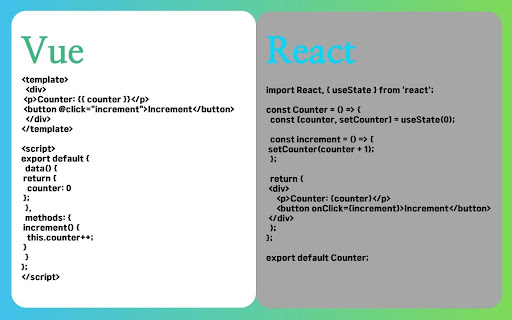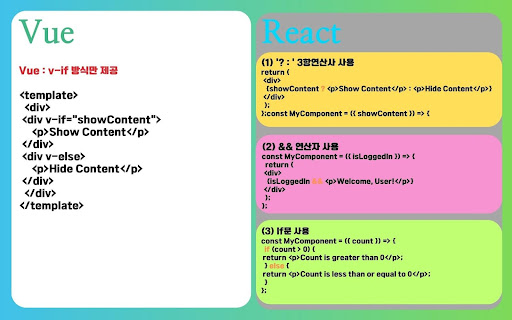When you consider an open-source JavaScript frontend framework that takes the best of Angular and React, compensates for their shortcomings, and focuses primarily on User Interface (UI) development, making it simpler to craft intricate, dynamic web pages, the tool that comes to mind is none other than ‘Vue.js’.
Regarded as one of the ‘Big Three’ in frontend development tools alongside Angular and React, Vue.js is immensely popular among developers, finding its use in real-time dashboards, social media apps, and e-commerce platform developments
What exactly is vue.js?

A standout feature of Vue.js is its lightweight size combined with its intuitive syntax, making it a preferred choice for SPA (Single Page Application) development.
Unlike traditional multi-page applications, which reload a new page from the server each time a user clicks a link, SPAs load the full page initially and then asynchronously fetch and update only the required data based on user interaction.
This not only enhances user experience but also bolsters the performance of the application.
The Genesis of Vue.js

Evan You, while working as a developer at Google using AngularJS, recognized the limitations of AngularJS and envisioned a more refined framework. AngularJS, despite its plethora of features and robust capabilities, was perceived as challenging to utilize, and its configuration for projects was complex.
Evan sought a lighter yet straightforward and adaptable frontend development tool. He particularly wanted a framework that could handle projects of all scales, from petite to immensely complex.
Driven by the need to address the complexities of AngularJS, which demanded developers to invest a significant amount of time and effort in setting up and maintaining projects, Evan You eventually introduced Vue.js to the world in 2014.
The Strength of Vue.js

Vue.js stands out as a lightweight and flexible frontend library. It draws from the strengths of React and Angular but offers ease of learning and simplicity in project configuration. While it shares similarities with Angular, being a component-based framework ideal for SPA development, there are distinct improvements that set Vue.js apart.
1. Lighter than Angular
While Angular offers an array of features, it can be intimidating for beginners. It’s associated with complex project configurations and a hefty framework size. In contrast, Vue.js is characterized by its simplicity and intuitive syntax, making it easy to learn and expedite development.
2. Enhanced Rendering through Virtual DOM
Unlike Angular, which manipulates the real DOM directly, leading to potential render slowdowns as application size and complexity grow, Vue.js leverages a Virtual DOM.
This allows for efficient rendering, minimizing DOM manipulations, thereby boosting performance. The Virtual DOM in Vue.js adopts a similar approach to React’s, focusing on updating only the changed elements in the real DOM.
By utilizing this Virtual DOM technique, Vue.js significantly improves browser rendering performance.
Why Developers Favor Vue.js

There are multiple frameworks, like React and Angular, available for web application development. One of the primary concerns for developers is deciding which of these three to adopt.
While React leads as the most popular frontend JavaScript framework, its learning curve, which includes grasping the new JSX syntax, can be steeper than that of Vue.js. Vue.js, on the other hand, is easier to learn, offers a myriad of libraries, and delivers rapid performance, making it the go-to choice for many enterprises. Let’s delve deeper into why developers tend to prefer Vue.js:
1. Similarity with Traditional Web Application Structure
One of Vue.js’s primary strengths is its ease of learning. Developers already versed in HTML, CSS, and JavaScript can seamlessly transition to Vue.js. The template format provided by Vue.js closely mirrors the conventional HTML and CSS-based webpage structure, simplifying the porting of existing projects to this new framework.
2. High Adaptability for Developers
Developers already proficient in traditional development skills, when tasked with a modern frontend framework project, tend to gravitate towards the user-friendly Vue.js.
3. An Integrated Framework for Web Development
Unlike React, which primarily focuses on UI rendering, Vue.js provides an all-inclusive framework. For instance, while React requires third-party modules like Redux for global state management and React Router for page transitions, Vue.js has built-in tools for these purposes.
It includes Vue js for state management and Vue.js Router for handling page transitions, offering a more integrated experience.
Why Vue.js is the preferred choice
When it comes to web application development, Vue.js, React, and Angular are the primary contenders in the frontend development framework realm. One of the pivotal decisions developers face is choosing which among these three to employ.
Vue.js is renowned for being the second most popular frontend JavaScript framework, trailing right behind React. Even though React is immensely popular, its new JSX syntax and steeper learning curve make it more challenging compared to Vue.js. In contrast, Vue.js is user-friendly, boasts a rich library ecosystem, and offers swift performance. Consequently, it’s favored by numerous businesses.
Let’s explore the reasons behind Vue.js’s popularity in more depth:
1. Resemblance to Traditional Web Application Structure
Above all, the simplicity of Vue.js is what makes it so appealing. If a developer has a background in HTML, CSS, and JavaScript, they can quickly adapt to Vue.js. Its template format, strikingly similar to traditional HTML and CSS, makes it convenient to port pre-existing projects to Vue.js.
2. High Adaptability for Developers
Developers who are familiar with traditional development techniques, when introduced to a contemporary frontend framework, overwhelmingly opt for Vue.js due to its ease of learning.
3. Comprehensive Framework for Web Development
Unlike React, which functions as a library centered on UI rendering, Vue.js operates as a holistic framework.
For instance, while React employs third-party modules like Redux for global state management and React Router for transitions between pages, Vue.js comes integrated with Vue jsx for state management and the Vue.js Router for page navigation.
Key features of Vue.js

With its ease of use and comprehensive toolkit, what makes Vue.js the go-to for many frontend developers? Some of the notable characteristics of Vue.js include ‘Two-way Data Binding’, ‘Component-based Architecture’, and ‘Swift Execution Speed’. Here’s a closer look at each:
1. Two-way Data Binding
Two-way data binding implies that any data alterations are automatically reflected on the UI, and conversely, any user input on the UI automatically updates the data. This bidirectional feature distinguishes it from React’s unidirectional approach, aligning it more with Angular’s method.
This advantage eradicates the need for developers to manually synchronize data with the UI, leading to less code and faster project construction, especially beneficial for UI components with abundant user interactions, such as form controls.
2. Component-based Architecture
Web interfaces consist of multiple elements – buttons, input forms, images, to name a few. Some of these might be unique, while others recur across different pages or even multiple times on the same page.
Vue.js’s component-based architecture facilitates the assembly of the UI using reusable mini-components, streamlining the construction of extensive web pages. This modular approach can be likened to building a vast structure using Lego blocks.
3. Lightweight with Fast Execution
Vue.js utilizes the Virtual DOM, enabling efficient rendering. By only updating altered segments and performing the bare minimum of DOM manipulations, Vue.js provides rapid rendering speeds and proficient update management.
The code-centric development convenience of vue.js

While we have previously touched upon the primary features of Vue.js, such as its performance advantages, component architecture, and inherent built-in tools, it’s equally noteworthy to emphasize its exceptional developmental convenience from a coding perspective.
Let’s take a closer look at how Vue.js stands out, particularly in contrast to another leading frontend tool: React.
1. Offering a Template Format akin to Traditional HTML

The template syntax of Vue.js is remarkably similar to traditional HTML development methods, making it a seamless transition for enterprises aiming to introduce a new SPA web application.
When comparing a Vue.js example that employs its template syntax to a React example using JSX syntax, Vue.js feels more intuitive and familiar for developers acquainted with HTML, thanks to its tag-based template approach.
2. Simplicity in Development (Unified Approach)
React offers multiple development paths for representing a specific webpage, leading to potential disparities in coding approaches among developers.

This flexibility, while beneficial for some, can be daunting for novices. In contrast, Vue.js champions a single, straightforward developmental approach, which ensures code consistency, especially when multiple developers collaborate. This uniformity greatly benefits team collaborations.
For instance, when crafting a dynamic screen that may or may not display certain content (elements) based on specific conditions (data), Vue.js simplifies this by exclusively offering the v-if directive for such dynamic representations.
Such design considerations make Vue.js an especially popular tool among beginners. Whether the team comprises seasoned developers, newcomers, or a mix of both, they can collectively choose Vue.js to steer their project efficiently.
The diverse Ecosystem and Tools of vue.js

In the world of web development, efficiency is the key. Vue.js paves the way by offering a multitude of tools and libraries, streamlining the development process. Here, we’ll introduce four primary libraries that pair seamlessly with Vue.js.
Vue.js Router:
This is the official router library of Vue.js, crucial for managing routing in Vue.js applications. It facilitates dynamic loading and management of views based on URLs, ensuring smooth transitions between pages.
Vue jsx:
State management is essential for the smooth functioning of any app. Vue jsx serves as the official state management library for Vue.js applications. By providing a centralized store, it efficiently manages app data and tracks state changes.
Vue jstify:
Designing user interfaces demands flexibility and aesthetics. Vue jstify is a material design component framework offering reusable components and styles, ensuring the Vue.js applications always stand out in design and functionality.
Nuxt.js:
For those who need more from their Vue.js application, Nuxt.js is the go-to framework. It excels by supporting server-side rendering (SSR) and code splitting. As a result, it optimizes for SEO and ensures faster loading speeds.
In addition to the above, the Vue.js community is a hotbed of innovation, constantly developing a range of tools and libraries. Depending on your project’s requirements, there’s always an option to pick the tool that fits best.
Dive into the world of Vue.js and witness the transformation in your web development journey!
Optimal Projects for Development Using Vue.js

Vue.js, renowned for its simplicity in crafting web applications, responsiveness for dynamic elements, and component-based architecture, is the framework of choice for a plethora of projects.
These range from news sites, e-commerce platforms, to dashboard creation. Let’s explore how the features of Vue.js can assist in developing each type of project.
1. Blogs or News Websites
Blogs and news sites primarily serve as content-centric web applications, aiming to provide a myriad of information to users. The component-based architecture of Vue.js allows the breakdown of content into smaller segments for development.
For instance, aspects like the news list, detailed news pages, sidebars, headers, etc., can be built as independent components. This modular approach enhances code reusability and simplifies maintenance.
2. E-commerce Applications
Vue.js shines in developing e-commerce applications, handling functionalities like product listings, shopping carts, the order process, and payments. Given the intricacies and feature-rich nature of e-commerce apps, the component-based, collaborative-friendly nature of Vue.js makes it an ideal choice.
By harnessing Vue.js, developers can dynamically display product listings, implement product search, filtering, and sorting functions, and manage the cart state using Vue jsx.
3. Dashboards
Dashboards serve to visually present diverse data, graphs, statistics, and more. They often require dynamic updates for various charts and graphs, where flashy UI elements and animations can enhance user experience. The lightweight nature and swift execution speed of Vue.js make it a fitting choice for dashboard development. Vue.js optimizes render speeds by updating only the parts that change via its Virtual DOM.
This ensures swift and seamless animations, providing users with a responsive experience. Plus, the component-based architecture aids in managing and enhancing the complex elements of a dashboard with ease.
Have you taken a closer look at Vue.js?
Vue.js, a leading JavaScript framework, is designed for its ease of use and a wide array of development tools.
Whether it’s a company blog disseminating the latest news and information, a distinctive landing page echoing brand sentiment, or a real-time dashboard that represents complex data at a glance, Vue.js is your go-to solution.
Need a hand in bringing your project to life?

Why not consider hiring a ‘Vue.js’ specialist from Elancer, South Korea’s pioneering and largest IT freelancer matching platform!
Elancer- South Korea’s Foremost IT Freelancer Matching Platform
With 23 years of rich data and expertise, Elancer is an avant-garde platform connecting innovative business projects with verified freelancers.
Over these 23 years, Elancer has overseen approximately 54,783 projects, handling projects worth over 95 billion won in total. If you’re on the lookout for top-tier IT freelancers, make Elancer your first port of call.
When Hiring IT Freelancers: Common Issues and How to Overcome Them

It’s a common scenario. Hiring IT freelancers or experts and then encountering communication issues that delay the project. Or, in worse scenarios, receiving an end product that is entirely different from what was intended.
When considering the hiring of IT freelancers, here are some essential aspects to check:
– Is the worker verified?
– Can you discuss and adjust the scope of work with the worker?
– Is there a dedicated project manager overseeing the work?
The time and energy required to confirm these points can be exhausting. And even after you’ve found the right expert to collaborate with, understanding their real potential before working together can be challenging. This is where platforms like ‘Elancer’ come in handy for all your IT freelancer hiring needs.
Why Choose Elancer for Your IT Freelancer Hiring Needs?
South Korea’s Largest Talent Pool – 390,000 Registered Freelancers:
Did you know Elancer boasts 390,000 registered IT expert freelancers?
This unmatched magnitude ensures you have the highest chance of finding the perfect match for your project.
With around 150 million service data points and 3.5 million freelancer evaluation data accumulated over 23 years, Elancer ensures that the freelancer’s expertise and character align with your project needs.
Take “IT” Easier.
Easier than you think,
IT freelancer matching!




